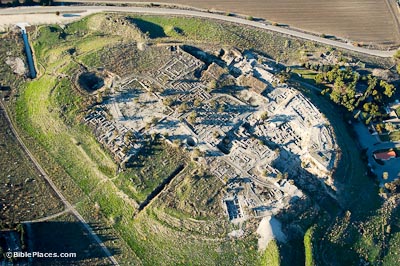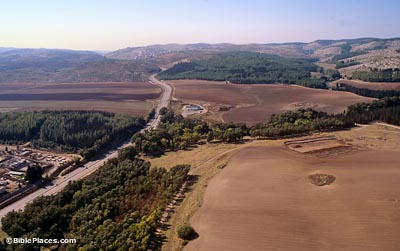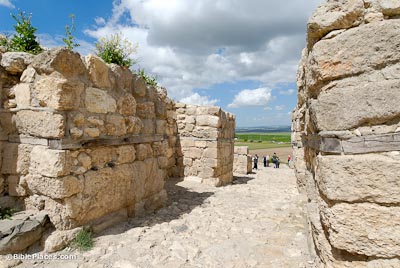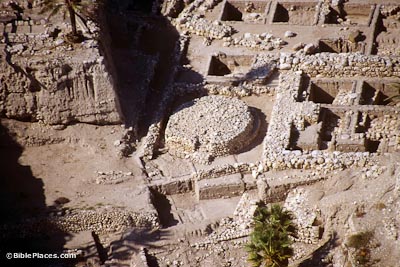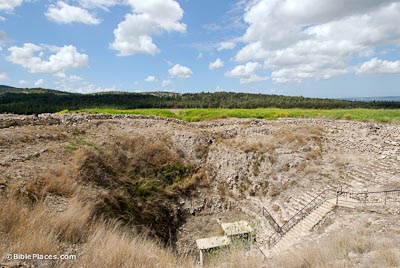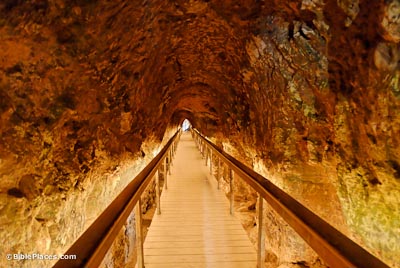Inhabited from the Chalcolithic period, Megiddo has approximately 26 levels of occupation. American excavators from the Oriental Institute worked from 1925 with the ambitious goal of excavating every level in its entirety. They made it through the first three levels before concentrating the work on certain areas.
Megiddo
Megiddo Pass
From the earliest times (Early Bronze) to the earliest historical records of the area (Thutmose III) to the future (Revelation 16), Megiddo assumes a prominent role. This is largely owing to its strategic location astride the Megiddo Pass (Wadi Ara) and inside the busy Jezreel Valley. The modern road follows the ancient one; the tel is just off the bottom right corner.
Middle Bronze Gate
Strongly fortified throughout the ages, Megiddo boasted a stone Syrian-type gate in the days of Canaanite inhabitation.
This gate is later than the bent-axis gate (straightened to accommodate chariots) and earlier than the famous “Solomonic” gate, part of the construction of King Solomon described in 1 Kings 9:15.
Early Bronze Altar
Part of a large religious complex from the third millennium BC, this sacrificial altar is striking in its size (33 ft, 10 m diameter) and location (behind the temple).
A staircase led up to the altar, a small temenos fence surrounded it, and large concentrations of animal bones and ashes were found in the vicinity.
Iron Age Watersystem
Needing secure access to its water supply, Megiddo utilized different watersystems over its history.
In the 9th century BC, Ahab constructed a massive system with a 100-foot (30-m) deep shaft and a 230-foot (70-m) long tunnel. This continued in use until the end of the Iron Age.
Tunnel to Spring
This Iron Age tunnel connected the bottom of Ahab’s shaft to the spring. Before its construction, Megiddo residents had to leave the city walls in order to get water from the spring.
This tunnel was hewn from both ends at the same time (like Hezekiah’s Tunnel) and its builders were only one foot (0.3 m) off when meeting in the middle.

Download all of our Samaria and the Center photos!
$39.00 $49.99 FREE SHIPPING
Related Websites
See the related sites of Gezer and Hazor.
Megiddo (See the Holy Land) Gives easy-to-read information on the location, biblical significance, etc.
The Megiddo Expedition (official page) Offers information on the site and its history as well as previous excavations and features a photo gallery.
Megiddo (Jewish Virtual Library) A nice background article about the site, not identical to the one below.
Archaeology in Israel: Megiddo (Jewish Virtual Library) Gives a detailed history of the site and descriptions of several important archaeological features.
Megiddo (Britannica) An encyclopedic type of article giving basics about the site.
Megiddo, the Place of Battles (Associates for Biblical Research) Featuring a few helpful photos, this site gives a comprehensive look at Megiddo, and includes a bibliography.
Tel Megiddo and What Megiddo Tells Us (Wayne Stiles) Considers the history and archaeology of Megiddo, and concludes with a modern takeaway.
Early Bronze Age: Megiddo’s Great Temple . . . (Bible History Daily) An extensive look into the EBA history of Megiddo, including helpful pictures and graphs.
Megiddo Dig Unearths Cache of Buried Canaanite Treasure (HaAretz) A 2012 article discussing an exciting find at the site.
Solomon’s Gate at Megiddo (Dig the Bible) A brief discussion of the Solomonic gate.
Residue Found in 3,600-Year-Old Holy Land Tomb Rewrites the History of Vanilla (Times of Israel) For those interested in both archaeology and food history, this article offers some fascinating information about the early use of vanilla, based on a discovery near Megiddo.
Twenty Years at Megiddo (Bible History Daily) This interview with archaeologist Matthew Adams not only introduces the reader to him, but also to the site.
